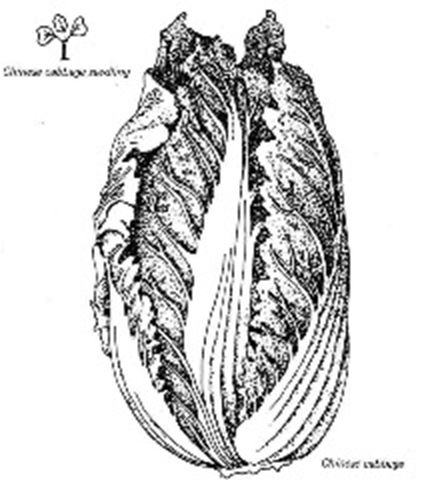Common names: Chinese
cabbage, white cabbage, flowering cabbage, celery cabbage, pakchoy, Michihii, Napa cabbage
Botanical name: Brassica chinensis
Origin: China

Varieties
Burpee Hybrid (75 days); Crispy Choy (pakchoy type, 53 days); Michihii (heading type, 72 days).
Description
Chinese cabbage is a hardy biennial grown as an annual, and it’s not a member of the cabbage family. It has broad, thick, tender leaves; heavy midribs; and can be either loosely or tightly headed and grow 15 to 18 inches tall. The variety with a large compact heart is called celery cabbage, pakchoy, or Michihii. In Chinese, call \tpe-tsai; in Japanese, say
hakusai. Despite the name, the appearance and taste of Chinese cabbage are closer to lettuce than to regular cabbage.
Where and when to grow
Chinese cabbage can be grown only in cool weather, because it bolts (goes to seed) quickly in hot weather and long days — it bolts much faster than the cabbage family vegetables. It’s usually grown as a fall crop in the North and as a winter crop in the South. It can be started inside and transplanted outside in the spring, but Chinese cabbage
shocks easily, and transplanting sometimes shocks it into going to seed.
How to plant
Chinese cabbage is difficult to grow in the home garden unless you can give it a long, cool growing season. Plant it four to six weeks before your average date of last frost. Even if the first fall frost arrives before the head forms you’ll still get a crop of greens. Chinese cabbage will tolerate partial shade. The soil should be well-worked and well-fertilized, high in organic matter and able to hold moisture. When you’re preparing the soil for planting, work in a complete, well-balanced fertilizer at the rate of one pound per 100 square feet or 10 pounds per 1,000 square feet. Sow seeds in rows 18 to 30 inches apart, and when the seedlings are large enough to handle, thin them to stand eight to 12 inches apart. Don’t even attempt to transplant Chinese cabbage unless you’ve started the seeds in peat pots or other plantable containers.
Fertilizing and watering
Fertilize before planting and again at midseason, at the same rate as the rest of the garden. Detailed information on fertilizing is given in “Spadework: The Essential Soil” in Parti.
Water frequently to help the young plants grow fast and become tender. They’ll probably go to seed if their growth slows down.
Pests
Flea beetles, aphids, and cabbage worms make Chinese
cabbage difficult to grow without spraying. Aphids can be partially controlled without chemicals by hand-picking or hosing, and cabbage worms can be controlled by spraying with bacillus thuringiensis, which is an organic product. Flea beetles usually must be chemically controlled with carbaryl, which will also control cabbage loopers. Detailed information on pest control is given in “Keeping Your Garden Healthy” in Parti.
Diseases
Yellows virus, clubroot, and black rot may attack Chinese cabbage. Cut down on the incidence of disease by planting disease-resistant varieties when they’re available, maintaining the general health of your garden, and avoiding handling the plants when they’re wet. If a plant does become infected, remove and destroy it so it cannot spread disease to healthy plants. Detailed information on disease prevention is given in “Keeping Your Garden Healthy” in Parti.
When and how to harvest
Time from planting to harvest is 50 to 80 days, and a 10-foot row should give you 10 or more heads. Harvest when the heads are compact and firm and before the seeds talks form. With a fall crop, harvest before hard-freezing weather. To harvest, cut off the whole plant at ground level.
Storing and preserving
Chinese cabbage stays fresh in the refrigerator up to one week, or in a cold, moist place for two to three months. You can also freeze
or dry it, and the seeds of Chinese cabbage can be sprouted. Detailed information on storing and preserving is given in Part 3.
Serving suggestions
Chinese cabbage has a very delicate, mild flavor, more reminiscent of lettuce than of cabbage. It makes an interesting slaw, with a sour cream dressing and a little chopped pineapple. Or serve it in wedges like cabbage. Of course, the ideal use is in Chinese stir-fry dishes and soups. Try shredding the Chinese cabbage with a bit of carrot, flavoring it with ginger and soy sauce, and dropping it in spoonfuls into oil in the wok. It’s crunchy and delicious. You can also butter-steam Chinese cabbage as an accompaniment to roast pork, or use the leaves to make cabbage rolls.
